NEW PODCAST! Control Your Inputs: Reduce Risk Through Growing Mix Selection
In Episode #38 of Tech On Demand brought to you by GrowerTalks, I’m joined by two dynamic guests for a discussion that’s equal parts informational and instructional (with a healthy dose of humor added to the mix!). The main focus is your growing mix selection.

I'm lucky to have two experienced and creative guests join me for this episode to share their thoughts, knowledge and advice to explore potential solutions for increasing crop quality and boosting efficiency. Pierre-Marc de Champlain and John Santoro from peat company Berger are here to explain ways to ease supply chain burdens using creative growing mix selection and incorporating different media components in the correct way.
The discussion begins with the current supply chain issues, both good and bad, and then moves on to why peat isn't only the backbone of soil mix components, but is also a very viable option now and in the future. Get ready to hear all about why responsible bog management is at the forefront of Berger’s approach and why this is good for the entire industry.
Next, Pierre-Marc and John share their thoughts on why flexibility is critical now more than ever, and they share ways to fine tune your production by looking closely at your media mix.
The episode wraps up with an explanation of the importance of trialing and creating a plan—and backup plan—related to growing media. Both of the guests have a lot of experience and unique takes on greenhouse production and I know you’ll find this episode engaging, informational and fun.

Nick’s Tip of the Week: Getting Ready for Garden Mum Season (Part 4 of 5)
Each week, I’ll work with my buddy Nick Flax, a technical services expert at Ball, to share a concern that’s come up during one of his numerous calls with growers across North America. This week, he’s getting back to diseases, with a focus on Botrytis.
PROBLEM: If you didn’t catch last week’s tip on best practices for mineral nutrition management in your garden mum crop, be sure to check it out in the TECH ON DEMAND ARCHIVES. Now let’s get back to pathogens. Botrytis (AKA gray mold) is a problem for most floriculture crops and garden mums are no exception.
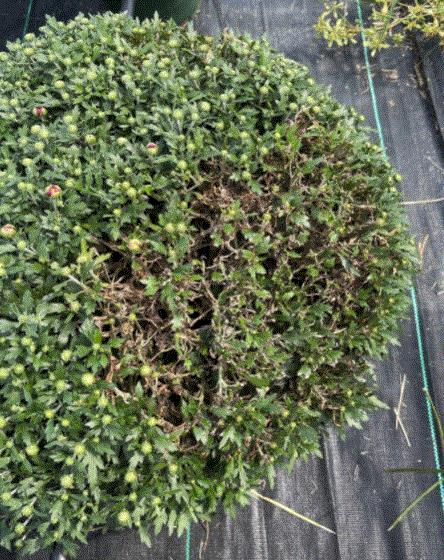
NICK’S TIP: Let’s discuss Botrytis basics, critical times during production when growers should pay special attention to pressure, and other dos and don’ts for managing this disease.
Factors for Infection, Symptoms & Key ID Characteristics
Gray mold prefers cool to moderate temperatures (about 65 to 75F/18 to 24C) and requires free water on the plant surface or very high humidity to infect. Typical Botrytis symptoms and signs include:
-
Chlorotic spots on leaves or stems that develop into brownish or gray, necrotic lesions. Lesions may be circular initially, but become irregularly shaped as disease progresses.
-
Characteristic signs include masses of fuzzy looking, grayish clusters of spores (hence the name “gray mold”) growing out of infected tissue.
Disease Management
Botrytis is best managed right before or right as environmental conditions become conducive to infection, so keep an eye on the weather—especially if you’re growing the crop outdoors. Impending rain and cool, cloudy conditions are a strong indicator that you should apply a fungicide, but here are some additional considerations for managing Botrytis throughout the production cycle.
-
From the time liners are planted to when the canopy closes within each pot, regular spraying for Botrytis is rarely necessary. If you can avoid overhead irrigation and rainfall is limited, crops are well fed and pots are spaced to provide ample airflow through each production block, gray mold is rarely a concern on recently planted and immature crops.
-
As the canopy first starts to tighten and airflow is restricted, scouting for early symptoms, such as chlorosis on leaves in the middle of the mound, becomes critical.
-
Botrytis infects and produces spores quickly on fallen leaves, which increases the chances of infection on living tissue nearby when conditions become optimal. Clean up fallen leaves in and around your pots to reduce the number of “reservoirs” in your crop, even if leaves are senescing naturally due to shading-out by the canopy above.
-
In mature crops (often a few weeks before sale), Botrytis leaf and stem blight can become a major concern. If you start to see early symptoms of infection, act quickly! Once a few shoots go down due to stem blight that nice, tight mound of foliage glazed with flower buds can quickly become a lopsided, homely looking mum.
The fact that this often happens when crops that are so close to finish and growers have put a whole season’s worth of inputs put into them drives home the importance of managing Botrytis late in the production cycle. While I don't advocate overuse of pesticides, exercising caution and doing a few additional sprays later in production may be the difference between a good year and a bad one for those of you who regularly lose plants to Botrytis late in the season.
-
Not all fungicides are created equal when it comes to managing gray mold. Check out this MSU Extension article with info on which active ingredients control Botrytis best.
-
Utilize fungicides with a good spreader-sticker (like Daconil WeatherStik) to help ensure good coverage, deep canopy penetration and staying power of the active during periods of persistent rains.
-
Be mindful of fungicide applications late in production and potential impacts to crop appearance. While chlorothalonil is highly effective at controlling Botrytis, it can discolor flowers, so avoid applying it to mature crops showing color. Other fungicides may leave a residue on the foliage, which may be unappealing to customers at retail. Be sure to read the label and know of any potential risks of discoloration or residues before applying.
Next week (the last week in our five-part series on getting ready for mum production), we’ll cover the final major mum disease that you should be on the lookout for—bacterial leaf spot.

Controlling Oxalis in Your Greenhouse Crops
I saw a recent e-GRO Alert packed with info about controlling oxalis (or Yellow Woodsorrel). Because it’s so prevalent in container production, it seemed like a good one to share here.
Oxalis seems to grow everywhere, so it’s not surprising to see it pop up in container plants. Debalina Saha from Michigan State University covers this annoying weed in detail, offering plenty of information about the plant, as well as strategies for pre-emergent and post-emergent control.
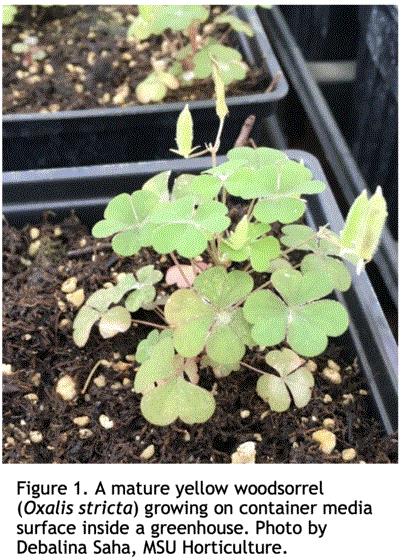
As is often the case, strict sanitation protocols and scouting go a long way in avoiding this quick-spreading weed. But if it’s already working its way through your crops, she cites research into chemical controls that have proven effective.
If you're dealing with oxalis or looking for ways to prevent it next season, check out THIS ARTICLE and keep it on file as part of your production plans.
Quick Tech Tip: Caterpillar Damage on Garden Mums
The Tech On Demand team recently received a question from a grower who spotted bugs and some seriously mangled foliage on some plants growing within his crop of garden mums. He mentioned he’d never seen this type of problem before and that he’d recently applied Florel. Wondering if this had anything to do with the problem, he reached out to us. Here’s the team's diagnosis:
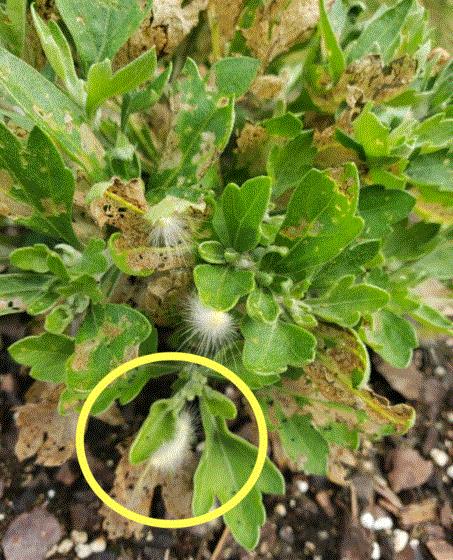
This is caterpillar damage. Look closely and you'll see them in the photos, as well as their frass (excrement).
To control, try Dipel, Conserve, Mainspring or insecticidal soap. Orthene will also work, although it can cause phytotoxicity on some varieties and in some conditions. Pedestal and Mavrik are additional options.
Another Mum Tip: Avoiding Fusarium BELOW Your Ground Cloth
It’s odd when only half of a plant collapses and that’s probably why this grower reached out to the Tech On Demand team for help. With only one cutting in the pot and half a plant looking terrible while the other half looks fine, we certainly have a conundrum. Here’s the diagnosis:
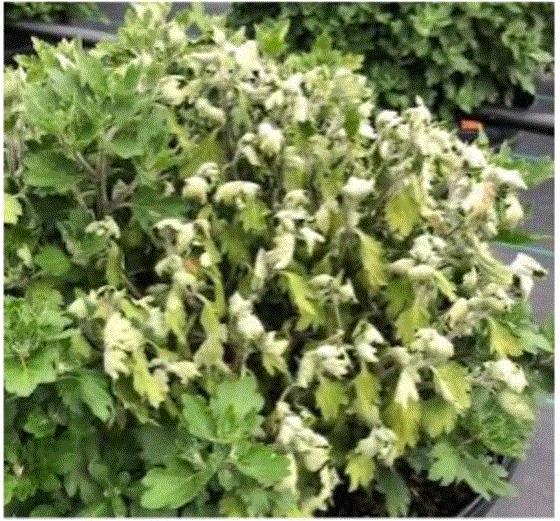
The problem is likely to be Fusarium stem infection, which is blocking the water uptake in the branches on one side of the plant. Clean stock and a fungicide application early in the crop cycle can prevent this if there’s a history of this problem.
The disease is resident in the soil, and when plants are grown on the ground, eventually the roots grow through the ground cloth and become infected by coming into contact with the Fusarium in the soil below the cloth.
Receiving & Handling HOT Poinsettia Cuttings
When the temps in my hometown of Cleveland hit 90 last weekend it reminded me that since poinsettia cuttings are starting to ship it might be a good idea to help you plan ahead for the inevitable shipments that will arrive in the heat of the summer. This is something growers seem to deal with every year in at least one region and because of that there are pretty clear steps to follow to minimize plant losses and maximize successful rooting. Here’s a quick VIDEO outlining the process.

When receiving your cuttings, use a digital thermometer to check temperatures throughout the box. Temps above 64F in the center of the box and outer edges indicate the plants have been warm for a while and you should cool them overnight. Temps closer to 50F mean the heat occurred later in the journey and damage will be much less likely. If possible, you might want to put them in the cooler overnight anyway.
When cooling your cuttings, set the cooler temp to 50F and pre-cool before putting cuttings in to avoid overcooling. You should remove cuttings from bags to disperse ethylene, or at a minimum open the bags up. Make sure your cuttings are moist and add water if needed. Cool them for a minimum of four hours, but overnight is best.
When you remove the cuttings from the cooler, check to make sure they’re firm and crisp before sticking.

Finish Line ...
One of the things I love most (besides horticulture, of course) is old stuff. I collect vintage and antiques across a few different themes—too many to list without boring most of you.
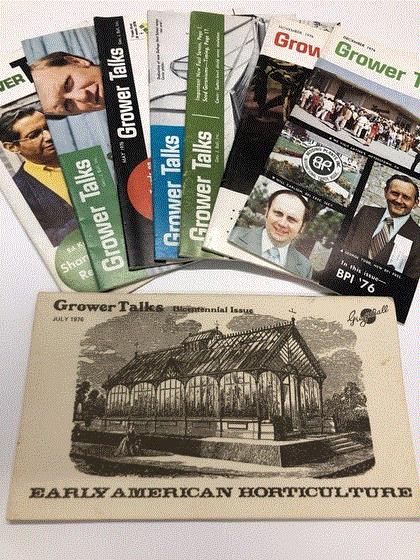
That said, I was super excited when Chris Beytes gave me a gift this morning when I got to the Ball offices in West Chicago. Check this out—an assortment of GrowerTalks magazines from 1976, my birth year!
The first thing I noticed was the size of the publications, a slim 8 x 4.5 inches, which is a handy size. The next thing I noticed was that each issue is filled with articles covering specific technical and cultural advice on different crops. Germination of Sprinter Geraniums, transplanting tips for Moonshot Marigolds, light requirements for Tampico Snapdragons, reducing Albadonna Cyclamen production time and disease control on Early Girl Tomatoes, just to name a few.
As I continue to flip through these issues, I’m reminded how important it is to stay up to date on new research and problem-solving techniques and how this solidifies the Tech On Demand mission to bring you the information needed to grow your best crops ever.
Now I’m going to get back to enjoying my old magazines. Have a fantastic week!



Please feel free to send your comments, constructive criticism and topic ideas to me at bcalkins@ballhort.com.

Bill Calkins
Editor - Tech On Demand
This email was received by you and 25,833 other fine subscribers!
If you're interested in advertising in Tech On Demand, contact Kim Brown ASAP and she'll hook you up.